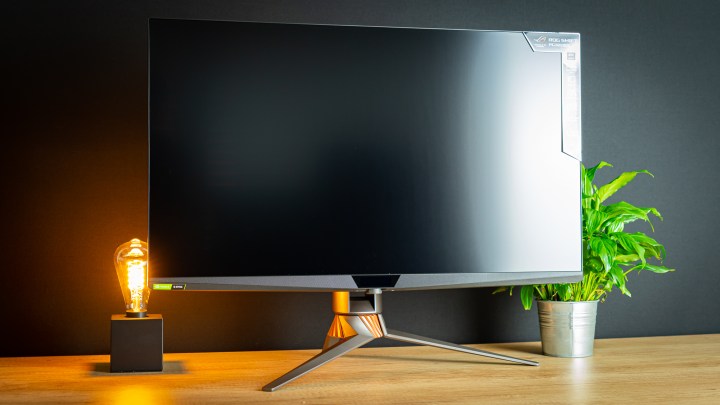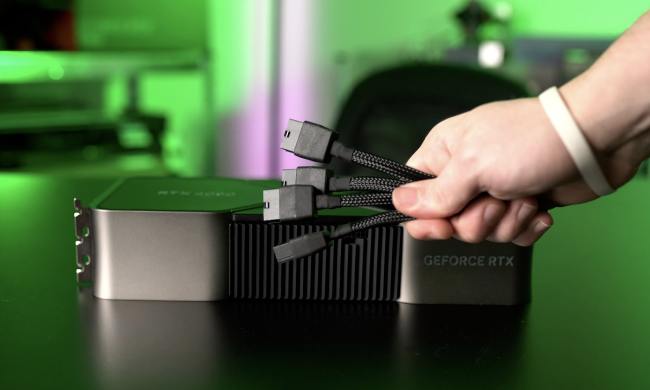“The Asus ROG Swift PG32UQX is a brilliant piece of PC gaming gear, but its flaws are hard to swallow.”
- Mind-blowing HDR performance
- Extremely high peak brightness
- Excellent colors
- Thread built-in for camera mounting
- Fast, fluid gaming
- No HDMI 2.1
- Has audible cooling fan
- Still not a perfect HDR experience
- Expensive
The ROG Swift PG32UQX was first teased around two years ago, and it hyped up the PC gaming community unlike any gaming monitor in recent history. You’ll find forum threads full of excitement. And for good reason.
According to Asus, the ROG Swift PG32UQX featured mind-blowing HDR performance unlike any other monitor that’s currently on the market. More than that, it was also the first 32-inch 4K gaming monitor based on Mini-LED technology, featuring Full-Array Local Dimming (FALD) for HDR illumination with 1,152 individual zones and a peak brightness of up to 1,400 nits.
The catch, of course, was its price tag. $2,999 is more than most entire PC gaming setups cost, including PC, monitor, and peripherals. As such, it’s only realistic to expect absolute and utter perfection. The ROG Swift PG32UQX does a lot of things amazingly well, but perfect it is not.
Design

The ROG Swift PG32UQX is quite a large monitor. That’s expected from a 32-inch display, but the PG32UQX is a little bigger than most 32-inch panels due to its FALD illumination panel, which adds a noticeable thickness to the display.
The design style is also quite aggressive, with Asus sparing no opportunity for the PG32UQX to be recognized as a Republic of Gamers product. The monitor’s stand features the new-but-classic tripod design with a downward-cast illumination stamp, the back of the display has strong shapes and a huge, RGB-illuminated Asus ROG logo, and the display’s big chin has a little OLED panel in it for displaying entertaining visuals or system information, such as CPU temperature.

Indeed, there is a lot to take in here. But if you’re not into the styling, it’s easy enough to shove the back of the monitor towards a wall, replace the stand with a VESA mount, and then you’ll be left with just the display’s chin that may look a little aggressive.
The little OLED display is quite nifty though – I doubt anyone will mind it especially because it’s customizable.
The display’s power brick is external, which I suppose is a good thing as otherwise the PG32UQX would have been even bigger, and at the top of the monitor you’ll find thread to insert a camera mount – I tried, and this monitor will happily hold my mirrorless camera with a big lens. Streamers, are you getting this?
There is even a USB port at the top right next to it for plugging your webcam or camera into without having to feel around behind the monitor.
Ports and controls

The ROG Swift PG32UQX packs a wide host of connectivity options, but it’s not complete. There are three HDMI 2.0 ports, a single DisplayPort 1.4a port, a three-port USB hub, and a headphone out jack.
But indeed, HDMI 2.1 is missing, and that’s a big one. HDMI 2.1 is now the go-to standard for multimedia connectivity, with all of 2020 and 2021’s GPUs and consoles featuring the interface. Without it, your Xbox Series X or PlayStation 5 won’t be able to run at 4K 120Hz with full color support, and that’s unacceptable for a high-end 4K monitor in 2021 – especially one that costs $3,000. Most new gaming laptops are even shipping with support for HDMI 2.1.
HDMI 2.1 is missing, and that’s unacceptable for a high-end 4K monitor in 2021.
There is a counter-side to that argument, and that is that there are still barely any PC monitors out with HDMI 2.1 in the first place. That, and the official Nvidia G-Sync module isn’t developed to support HDMI 2.1 yet. Regardless, I find it inexcusable on a monitor of this price and caliber. If you plan on using the PG32UQX with a modern console, keep in mind that you’ll be limited to 60Hz or have to make color sacrifices: You will never have an optimal experience.
The display’s OSD has slightly odd controls with a spinning wheel in the middle and a button to each side, but it is easy to navigate and most of the required settings are present.

However, in HDR mode, there is no brightness control, which is a problem. One can argue whether this matters as brightness in HDR is meant to be controlled by the PC and not the monitor, but I still prefer seeing some form of brightness modifier at all so that the baseline brightness can be adjusted to a comfortable level for the room.
There is a cooling fan
Before wrapping up, there is one more drawback that’s worth mentioning: the display has a cooling fan. It turns on the moment the display does, and while it isn’t loud, it is audible. This isn’t a problem if you use headphones or have silent music playing, but it may bug you if you enjoy a silent room and have an otherwise quiet computer.
Mini-LED and HDR
If there’s one reason you’re interested in buying the PG32UQX, it’s Mini-LED and its HDR performance. I’ll start with the good stuff: When using proper HDR content, the visuals the PG32UQX is able to produce are nothing short of astonishing. As if the monitor wasn’t worth its asking price this whole time, it suddenly was, almost.
LCD panels are unable to block out all of the light, even on black, meaning the ability to dim select areas (HDR on PC monitors, explained) is necessary to achieve full black levels. Dimming select areas also allows the display to increase peak brightness in a small area without over-illuminating the entire display. Most PC monitors are edge-lit, with one lamp illuminating the entire display. On ‘better’ HDR monitors this edge-lighting will be split into a minimum of eight zones, illuminating select columns of the display as demanded.
However, as you can imagine, this illuminated column effect is undesirable, which is why manufacturers are experimenting with Mini-LED: an illumination technique that rather than edge-lighting the display, places an array with a huge number of individually controllable LEDs directly behind the panel. This illumination technique is called Full-Array Local Dimming (FALD), and in the PG32UQX’s case, that’s 1152 zones, offering lavishly fine local dimming control.
In a way, FALD actually fixes the major drawbacks of IPS panels: Backlight bleeding and IPS glow are no longer a problem because the afflicted area just isn’t illuminated when displaying black. The static contrast ratio isn’t as relevant either again, because the area simply wouldn’t be illuminated when displaying a black image.

Individual zones can peak at up to 1,400 nits of brightness when displaying highlights, and although I was unable to test this number due to my tester’s limitations, I’ll take Asus’ word on it: Bright lights, the sun, fires, and other highlights really popped off the screen in almost eye-searing brightness, which was really a sight to behold when just to the left of said object an area would be fully dark, displaying an inky-black night sky.
This kind of realistic luminosity control is exactly what HDR is all about, and the PG32UQX more than delivers. Especially in games running at higher framerates with G-Sync enabled, the PG32UQX is a joy to use. It’s not the fastest panel, but it’s plenty fast for non-competitive gameplay.
Fire up a game that does HDR properly, and you’re in for a spectacle.
But the technology isn’t perfect. The IPS panel is only capable of blocking so much light, and although 1,152 zones is magnitudes superior over an edge-lit display with 8 zones (which barely feels like HDR at all after experiencing the PG32UQX), they are still visible zones, especially on darker scenes. Plain desktop use is the worst offender to this — take a black or dark background, and hover your mouse over it: You’ll see a round halo of blue light nervously following around the mouse as it jumps between zones. Or grab a white dialogue box on a dark background, its edges will have an odd yellow sheen on them. You can get used to this effect, but ignoring it is difficult and you will always be reminded of how the technology is still imperfect.
However, desktop use isn’t really a fair test, as individual elements are often far too small for the zones. It doesn’t address the higher peak brightness levels, and Microsoft’s HDR implementation still needs refinement. But with dynamic content, such as games, movies or tv shows, the halo effect is far less prominent. That’s because individual bright elements are often bigger, but also because there’s just far more movement happening on-screen.
Fire up a game that does HDR properly, go into the settings and properly calibrate the peak darkness and peak brightness levels so that the game engine correctly addresses the HDR brightness responsivity of the monitor, and you’re in for a spectacle. Trust me, you’ll forget all about the halo-effect with games and videos.
Image quality
Thanks to its IPS panel, the PG32UQX has great color performance, which paired with the 4K resolution at the 32-inch size make it a dream as an editing display, especially if you produce HDR content.
We tested the monitor in SDR mode as our tester doesn’t do HDR, and the panel’s color performance does impress. At the start of testing, I ran into the sRGB color clamp pinning color coverage at a perfect 100% of sRGB, which is a much-appreciated feature: unclamped sRGB colors can often look over-saturated on wide-gamut monitors, so it’s nice to see the inclusion of this limiter.
With the clamp off, the panel covered a tidy 100% of the AdobeRGB and 97% of the DCI-P3 color spaces, with color accuracy rated at a Delta-E (difference from real) of 1.77. Any Delta-E under 2 is considered good enough for professional work. Calibrating the display did not yield any significant improvements, but its performance is plenty good out of the box.
Gamma performance was also perfect, though I was unimpressed with the panel’s native static contrast ratio. Whereas IPS panels, especially flat samples generally pin a result of about 1000:1, the best recorded contrast ratio I achieved in testing this sample was 810:1, which is what I would expect from a curved IPS panel that bleeds a little more due to the pressure. But this is a flat panel.

That being said, this was tested without HDR and the panel’s variable backlight feature switched off. We test like this to properly judge the panel’s native contrast ratio without automated changes in the backlighting interfering with the result. With variable backlighting switched on, the contrast ratio was much better, genuinely producing deep blacks even in SDR mode – and I reckon that most people using this monitor will want to leave the variable backlighting feature enabled. The only exception would be when doing color-critical work as dimmed backlighting does cause color shift in the adjacent areas.
This raises the question of how much it really matters that the panel’s contrast performance isn’t great, which is a difficult question to answer. On the one hand, it shouldn’t matter with this kind of backlighting, but a panel with better static contrast performance would do a better job at blocking light, and thus do a better job at combatting the haloing exhibited by the PG32UQX.
Do keep in mind that contrast performance is something that varies greatly from sample to sample, and given that I feel this sample performed at the bottom end of the spectrum with other reports stating much higher contrast ratios, chances are you’ll have better luck.
What about OLED as an alternative?
If you’re looking for the perfect HDR experience that doesn’t have any haloing under any circumstances, chances are that you’re thinking something along the lines of ‘what about just getting an OLED panel instead?’ and I wouldn’t blame you for it. In fact, that’s a good idea, but OLED panels do come with their own sets of perils.
The attraction would be that each pixel is its own light source. One pixel could be lit at peak brightness, and those directly adjacent to it pitch black. No halo-ing, just pure and perfect luminosity control across the panel. HDR would look great in the windows desktop and in all movies and games with no visual sacrifice.
But, there are a few catches. First and foremost, there are no OLED PC gaming monitors, and the smallest OLED TV’s currently come in at about 48-inches in diagonal. That’s a little big for use on a desk as a PC monitor, especially without a curve. They’re also all glossy, burn-in is a potential risk especially with the amount of static content PC desktop use pertains, and to mitigate burn-in, peak brightness is also limited so you’ll never quite get that “I have to look away because it’s so bright” level of immersion.
At the end of the day, the choice between Mini-LED and OLED is one of concessions: Which will you be able to tolerate, and which will you not. But if you’re asking yourself whether you should get the PG32UQX or an OLED TV for content consumption, then the PG32UQX is probably not for you – an OLED TV might not last as long, but it costs less than half as much – and I’ll bet that the PG32UQX will depreciate faster than an OLED will reach $0 in value.
Our take
The Asus ROG Swift PG32UQX is an amazing piece of equipment. With an array featuring 1,152 Mini-LED illumination zones, it produces an HDR experience that is unlike any other PC monitor currently on the market. There already aren’t many 32-inch 4K gaming monitors on the market in the first place, so sitting in front of one that not only comes in that size, but also has FALD illumination is like sitting in front of a unicorn. At least at this time, the PG32UQX offers the most stunning HDR performance available on PC without turning to an OLED television.
The PG32UQX is at the cusp of what PC monitor technology can do nowadays, and if you’re after an HDR spectacle for your desk, it’s the tool for the job. But like any cutting-edge technology, it’s far from perfect and in that respect, the PG32UQX feels a bit like a prototype: there is no HDMI 2.1 so it’s not exactly future-proofed and I feel the Mini-LED technology, while it looks good now, will soon be outdated due to new developments. Add to that the usual panel performance lottery, no baseline HDR brightness control and an annoying cooling fan, and it quickly becomes a very challenging proposition to spend $2,999 on a monitor.
Are there any alternatives?
No. There are currently no other PC monitors that offer fast, 4K gaming performance paired with FALD and this level of color performance. Your other best bet is an OLED TV like LG’s 48-inch C1 model, but that comes with its own set of compromises, provided you have the desk space for it at all.
How long will it last?
From a functional perspective, I see no reason why the ROG Swift PG32UQX couldn’t last a minimum of five years. But between the lack of HDMI 2.1 and rapidly developing alternative display technologies, you’ll likely itch to replace it long before it breaks, especially if you’re someone that likes to live at the forefront of technology.
Should I buy it?
For most gamers, no. It has a few flaws that are guaranteed to be dealbreakers for large groups of buyers, especially at this price.
If you have deep pockets, and just want the best HDR gaming monitor you can currently buy right now, then the ROG Swift PG32UQX is as good as it gets But for most of us it’s like an exotic sports car: I’d like to rent it, just to experience it, but I wouldn’t want to own it.






